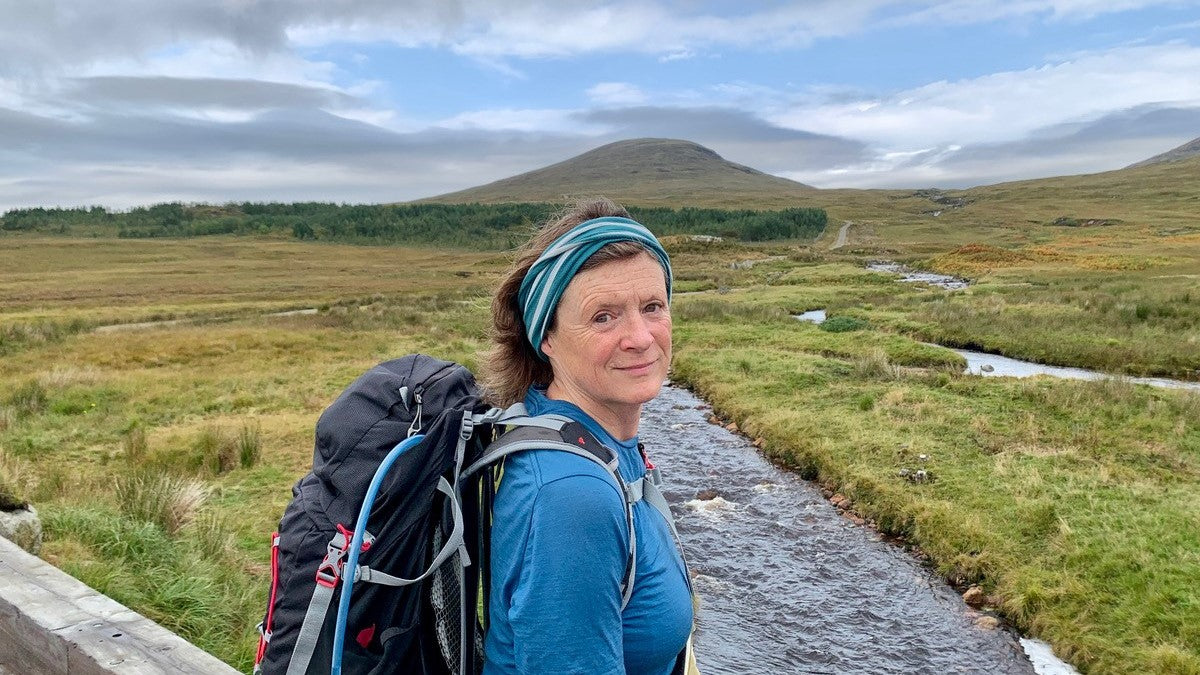Linda Cracknell is an Aberfeldy-based writer of fiction and non-fiction. Walking and immersion in the natural world are essential to her craft as espoused in books such as Writing Landscape and Doubling Back: Paths Trodden in Memory, the latter of which will be re-released in May 2024. Join us for the launch party at the Glen Lyon Coffee roastery on May 23rd.
In advance of the launch, we spoke with Linda about her career and the lure of the outdoors.
Could you tell us a little about the journey that you took to become a full-time writer?
Starting to write coincided with arriving in Aberfeldy in 1995 for a job with WWF Scotland (World Wide Fund for Nature). I was trying my hand at short stories and had a lucky break early on with a story about a life drawing model in an art college who – whilst naked, revealing all – was concealing grief after the death of her husband. In 1998 it won a prestigious competition – the Macallan/Scotland on Sunday prize – and 'Life Drawing' became my first published work. My first two books were collections of short stories.
In 2005, I halved my income and became self-employed as a writer and teacher/facilitator of other people's writing. It’s what I’m still doing after six books, several plays for BBC Radio 4 and hundreds of notebooks full of scribble. I've been lucky to be able to travel with this work including running residential workshops in the Moroccan Sahara.
You started as a short story fiction writer but in recent years have also focused more on non-fiction travel and memoir. Could you explain a little more about this change of direction?
Fiction remains my writing ‘home’, most recently with the novel ‘The Other Side of Stone’ (2021) set in a Perthshire woollen mill between 1831 and 2019. Occasional switches into non-fiction have come about through my passion for being outdoors and the importance of walking to my creative process. I ‘walked-up’ my first novel, ‘Call of the Undertow’ with circuits of dunes, beach, and the secret woodlands of a bare, scouring place in coastal Caithness.
But I’d also begun to write non-fiction reflections about places, memory and walking including regular pieces for Walk Highlands. Last year a book of essays about writing and close attention to nature was published: 'Writing Landscape', and ‘Doubling Back’ focusses on specific walks which overlay previous journeys.
What was the idea behind Doubling Back and could you explain a little more about the process of writing it?
In 2004 I went to Norway with an old friend and her siblings to re-walk the route to Sweden taken by their Norwegian father as he escaped Nazi pursuit and certain execution in World War II. He had been caught taking photographs at a coastal torpedo station. Along his Norway-wide route, older people who had helped him came out to meet us and pointed out his landmarks and hiding places. Afterwards I wanted to write about this journey but also thought of other paths which carried history, including my own father’s, who was a keen mountaineer and had died of cancer when I was very young. His ‘story’ took me high into the Swiss Alps, way beyond my comfort zone.
Other walks I ‘Doubled back’ onto included Scottish drove roads, medieval ways engineered through the rugged mountains of south-east Spain, and formative places for two writers – Thomas Hardy and Jessie Kesson. I walked with a tiny notebook in my pocket, a pencil attached by a piece of string, and took notes along the way. I found out about myself whilst discovering the world. However, the process of creating a coherent book from these journeys took several years of sitting down rather than walking!
Why are you re-publishing doubling back?
Doubling Back was originally published in 2014 but disappeared with the sudden collapse of the publisher in 2017. It had been very well received and was a BBC Radio 4 Book of the Week. The original ten walks are included in the 2024 edition from Saraband Books but there’s also a further one in Scotland's Flow Country, an often disregarded or maligned expanse of peat bog which is critical for carbon storage and thus to the climate crisis. Perhaps this walk focuses the new edition a little more onto the future.
Why do you think writing around walking and landscape is so popular at the moment?
I’m delighted to see this literature grow, and it’s no longer a male preserve – many women are now writing about their diverse engagement with places and journeys on foot. Walking for many increased during the Covid lockdown – a way of getting out, staying healthy and appreciating nature. This has perhaps expanded such readership.
But more than this, there seems a welcome groundswell of reconnection to the primal, to paying attention and recognising ourselves as part of nature, with responsibilities to it as well as to future human generations. Some of the great issues of our time need us to think in new ways.
What are you working on now?
I'm in the last throes of a memoir exploring my seafaring ancestry in North Devon on my mother's side of the family – they were ‘Drakes’ – and a new novel set between the Scottish Highlands, Southern Spain and the Alps. And I’m still scribbling in countless notebooks…
The launch party for Linda's book Doubling Back will take place at Glen Lyon Coffee on Thursday May 23rd, 2024 at 6pm. Entry is free but please book your tickets here.
Linda will also be co-hosting a writing and walking workshop with mountain leader and Glen Lyon director Jamie Grant on Saturday 1st of June. Tickets are £45 and this event is limited to six participants. More information and tickets here.

